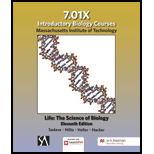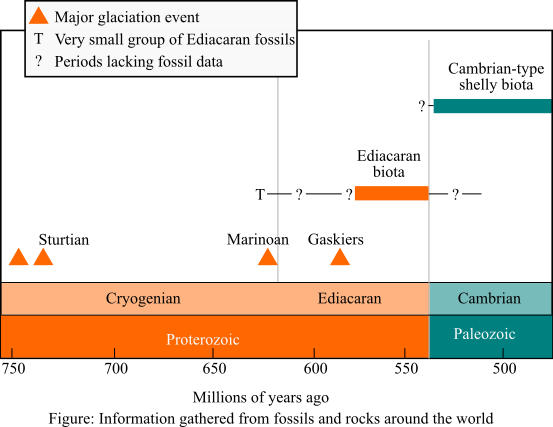
Concept explainers
To review:
The difference between the geological strata, in which Ediacaran fossils and Cambrian-type shelly biota fossils were discovered.
Given:
The diagram given below shows the evidence of fossils and rocks from places all over the world:

Introduction:
A stratum is a layer formed of sedimentary rocks or igneous rock. The earth’s surface generally consists of one kind of matter having a continuous deposition. The Ediacaran period lasted from about 635 to 542 million years ago (mya) and the Cambrian period lasted from 541 to 485 mya.
Explanation of Solution
The difference between the Cambrian strata and the Ediacaran strata are given in the table below:
Table: Difference between Cambrian and Ediacaran strata
| Cambrian strata | Ediacaran strata |
| The Cambrian period is the period of ancient life that lasted about 500 mya and it is known for dramatic evolutionary changes in the life on earth. | The Ediacaran period lasted from about 550 to 600 mya and is mostly characterized by soft-bodied and sessile animals. |
| Cambrian strata did not witness any glaciation event. | Ediacaran strata faced a major glaciation event. |
| The Cambrian strata show a wide variety and number of fossil records. | Ediacaran strata have a very sparse fossil record because the soft-bodied animals could not be fossilized. |
Thus, it can be concluded that the Ediacaran strata do not have a well-established fossil record because its biota consisted mainly of soft-bodied animals and they faced a major glaciation event.
Want to see more full solutions like this?
Chapter 24 Solutions
LIFE:SCIENCE OF BIOL.(LL) >CUSTOM<
- Reactunts C6H12O6 (Glucose) + 2NAD+ + 2ADP 2 Pyruvic acid + 2NADH + 2ATP a. Which of the above are the reactants? b. Which of the above are the products? c. Which reactant is the electron donor? GHz 06 (glucose) d. Which reactant is the electron acceptor? NAD e. Which of the products have been reduced? NADH f. Which of the products have been oxidized? g. Which process was used to produce the ATP? h. Where was the energy initially in this chemical reaction and where is it now that it is finished? i. Where was the carbon initially in this chemical reaction and where is it now that it is finished? j. Where were the electrons initially in this chemical reaction and where is it now that it is finished? 3arrow_forwardThere is ________ the concept of global warming. Very strong evidence to support Some strong evidence to support Evidence both supporting and against Evidence againstarrow_forwardHow many types of reactions can an enzyme perform?arrow_forward
- Your goal is to produce black seeds resistant to mold. So you make the same cross again (between a homozygous black seeded, mold susceptible parent and a homozygous white seeded and mold resistant parent), and, again, advance progeny by SSD to create 100 F10 generation plants. Based on the information you obtained from your first crossing experiment (Question #4), how many F10 plants would you expect to have black seeds and be resistant to mold? Assume that a toxin produced by the mold fungus has been isolated. Only mold resistant seeds will germinate in the presence of the toxin. Could you use this toxin screening procedure to have segregation distortion work in your favor in the F2 generation? Explain your answer. Info from Question 4 a. P Locus (Seed Color): Hypothesis: The null hypothesis (H₀) is that seed color is controlled by alleles at a single locus. Observed Data: Total white seeds: 45 (resistant plants) + 6 (susceptible plants) = 51 Total black seeds: 7 (resistant…arrow_forward10. Consider the following enzyme and its substrate where the "+" and "-" indicate cations and anions, respectively. Explain which of the following inhibitors could inhibit this enzyme? Which type of inhibitor would it be and why? (Video 5-2) Substrate Enzyme Potential inhibitorsarrow_forwardUsing Punnett Squares Punnett squares are one good way to predict the outcome of genetic crosses. Punnett squares use mathematical probability to help predict the genotype and phenotype combinations in genetic crosses. The number of possible alleles from each parent determines the number of rows and columns in the Punnett square. Independent Assortment KEY QUESTION How do alleles segregate when more than one gene is involved? Mendel wondered if the segregation of one pair of alleles affects another pair. For example, does the gene that determines the shape of a seed affect the gene for seed color? This type of experiment is known as a two-factor, or dihybrid, cross because it involves two different genes. Single-gene crosses are monohybrid crosses. Visual Reading Tool: Two-Factor Cross: F₂ The Punnett square shows the results of self-crossing the F, generation of a cross between round yellow peas and wrinkled green peas. 1. List the different genotypes in the F, generation. What is the…arrow_forward
- CHAPTER 12 LESSON 2 Applying Mendel's Principles READING TOOL Connect to Visuals Before you read, preview Figure 12-7. Try to infer the purpose of this diagram. As you read, compare your inference to the text. After you read, revise your statement if needed or write a new one about the diagram's purpose. Take notes on the lines provided. Then view the Punnett square and answer the questions below regarding the genotypes and phenotypes. Inference: Revision: Parent 2 rryy Gametes F ry Parent 1 RRYY Gametes RY RrYy The F, generation are all RrYy. 1. What is the phenotype of parent 1?. 2. What is the genotype of parent 1? 3. What is the phenotype of parent 2? 4. What is the genotype of parent 2? 5. What is the phenotype of the F, offspring?. 6. What is the genotype of the F, offspring?. 7. What kind of cross does this figure describe? 144 Chanter 12 Introduction to Genetice Copyright Pearson Education Inc. or its affiliator. All rights reserved.arrow_forwardHow is the term enzyme related to the term proteinarrow_forwardCan very low temperatures cause proteins to denature? Explain why or why not?arrow_forward
- Humans consider themselves amazingly clever and innovative, constantly developing "new" ways of altering the world around us. As material consumption has increased, many have turned to the ideas of recycling and reuse as a means to minimize some negative aspects of our modern consumerism. Mother Nature though is the ultimate innovator and, more importantly, the ultimate recycler.arrow_forwardH gene assorts independently from the I gene. Both on autosomes. One man and one woman, both of HhIAIB genotype. Determine the blood type of progeny and fractions out of 16arrow_forwardAlleles at the P locus control seed color. Plants which are pp have white seeds, white flowers and no pigment in vegetative parts. Plants which are P_ have black seeds, purple flowers and may have varying degrees of pigment on stems and leaves. Seed color can be assessed, visually, based on if the seed is white or not white A gene for mold resistance has been reported and we want to determine its inheritance and whether it is linked to P. For the purposes of this exercise, we will assume that resistance is controlled by a single locus M, and M_ plants are resistant and mm plants are susceptible. Resistance can be measured, under greenhouse conditions, 2 weeks after planting, by injecting each seedling with a spore suspension. After two weeks, the seedlings can be rated as resistant or susceptible, based on whether or not tissue is actively sporulating. For this exercise we will use seed and data from the F10 generation of a recombinant inbred population produced using single seed…arrow_forward
 Biology Today and Tomorrow without Physiology (Mi...BiologyISBN:9781305117396Author:Cecie Starr, Christine Evers, Lisa StarrPublisher:Cengage Learning
Biology Today and Tomorrow without Physiology (Mi...BiologyISBN:9781305117396Author:Cecie Starr, Christine Evers, Lisa StarrPublisher:Cengage Learning
 Biology (MindTap Course List)BiologyISBN:9781337392938Author:Eldra Solomon, Charles Martin, Diana W. Martin, Linda R. BergPublisher:Cengage Learning
Biology (MindTap Course List)BiologyISBN:9781337392938Author:Eldra Solomon, Charles Martin, Diana W. Martin, Linda R. BergPublisher:Cengage Learning Biology: The Dynamic Science (MindTap Course List)BiologyISBN:9781305389892Author:Peter J. Russell, Paul E. Hertz, Beverly McMillanPublisher:Cengage Learning
Biology: The Dynamic Science (MindTap Course List)BiologyISBN:9781305389892Author:Peter J. Russell, Paul E. Hertz, Beverly McMillanPublisher:Cengage Learning Concepts of BiologyBiologyISBN:9781938168116Author:Samantha Fowler, Rebecca Roush, James WisePublisher:OpenStax College
Concepts of BiologyBiologyISBN:9781938168116Author:Samantha Fowler, Rebecca Roush, James WisePublisher:OpenStax College Human Biology (MindTap Course List)BiologyISBN:9781305112100Author:Cecie Starr, Beverly McMillanPublisher:Cengage Learning
Human Biology (MindTap Course List)BiologyISBN:9781305112100Author:Cecie Starr, Beverly McMillanPublisher:Cengage Learning





